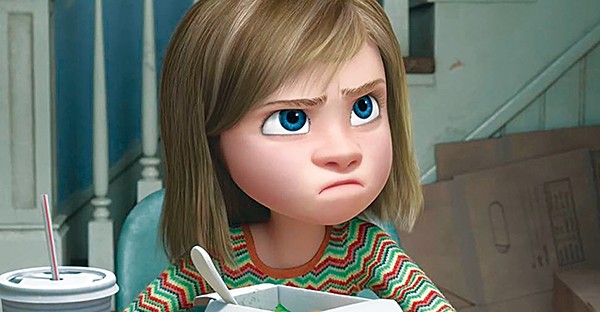Whenever I hear about a new Pixar movie, I get excited. Maybe Cars 2 wasn’t up to the incredibly high standards the studio set with The Incredibles and Wall-E, but it’s still more entertaining than 90 percent of movie-like products extruded every year. Months ago, when I heard about Inside Out, I was a little dubious. The concept of personifying the dueling voices in your head as you debate how to get through life was tried in a short-lived TV series from the 1990s called Herman’s Head, not to mention the infamous sperm paratrooper sequence in Woody Allen’s Everything You Always Wanted To Know About Sex, But Were Afraid To Ask. Could the crack troops at Pixar successfully mine this hackneyed premise, or was this going to be another Monsters University misfire?
You betcha they could! Inside Out is wall-to-wall brilliance that will be spoken of alongside Toy Story and Up as the best of Pixar’s legacy.
The little girl whose head we’re inside is named Riley (voiced by Kaitlyn Dias) She’s being piloted from a cerebral control room by a team of emotions led by Joy (Amy Poehler). Riley’s reactions to the events of her life are determined by a running debate between Joy, Fear (Bill Hader), Sadness (Phyllis Smith), Disgust (Mindy Kaling), and Anger (Lewis Black, obviously). Things are going along fine for the happy 11-year-old until her family moves from small-town Minnesota to San Francisco. The family encounters irksome but predictable, problems adjusting to the new environment. The moving van with all of their possessions gets lost. The house they move into isn’t as nice as the one they left behind. People in San Francisco put broccoli on pizza.

Riley
Riley’s bridge crew works to keep her on track with Joy at the helm, but as things get hairy, the emotions find themselves on a sinking ship. An accident throws Joy and Sadness out of Headquarters, leaving Fear, Disgust, and Anger alone to run the show. As Riley’s young life starts spiraling out of control, the opposites Joy and Sadness must work together to find their way through her memories and unconscious mind and return to the control room.
Pixar veteran Pete Docter is Inside Out‘s ostensible mastermind, but in the famously collaborative Pixar spirit, he shares his director’s credit with animator Ronaldo Del Carmen. Their work visualizing abstract psychological concepts is creative, fun, and illuminating. Both Riley’s drab, everyday existence in San Francisco and the riot of color and shapes in her head are perfectly rendered, and the stories told in both environments complement and inform each other. Every detail has been thought through and perfectly executed. There are references to Chuck Jones, Hayao Miyazaki, and early Disney collaborator Ub Iwerks, as Sadness and Joy travel through Imagination Land and the experimental Abstract Thought chamber. There’s not a false note anywhere in the talented voice cast, but Poehler and Richard Kind, who plays Riley’s long-neglected imaginary friend Bing Bong are the two standouts. There’s even a Frank Oz voice cameo!
Like classic Looney Tunes, Inside Out is ostensibly directed at kids, but speaks even deeper volumes to adults. It’s funny and exciting, and its lessons go down easy. Significantly, the film posits that the worst case scenario is not a mind consumed with sadness, but one that can no longer feel anything. Joy’s ultimate embrace of the other emotions to create a richer life experience for Riley is both moving and sharply observed. Docter also takes the occasional aside to look at the emotional debates going on in the minds of characters other than Riley to emphasize that everyone has his or her own struggle. Its central theme of staying aware of the different emotional and cognitive forces pulling you to and fro as you go through life seems like an extremely valuable lesson for children. Frankly, it’s pretty valuable to me, too. Inside Out is a movie I wish I had seen a long time ago.